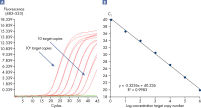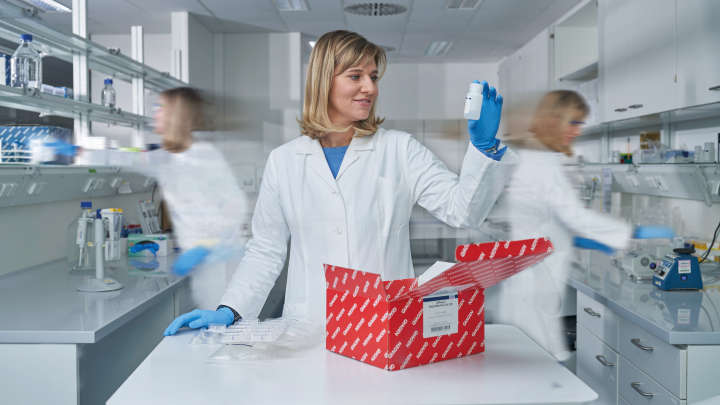Configure at GeneGlobe
Find or custom design the right target-specific assays and panels to research your biological targets of interest.
Microbial DNA qPCR Arrays
Cat no. / ID. 330261
Array plate and master mix for detection of microbial species or genes
Configure at GeneGlobe To see pricing
Microbial DNA qPCR Arrays are intended for molecular biology applications. These products are not intended for the diagnosis, prevention, or treatment of a disease.
Configure at GeneGlobe
Find or custom design the right target-specific assays and panels to research your biological targets of interest.
Features
- Profile microbial species, virulence genes, or antibiotic resistance genes
- Simple procedure for a variety of sample types
- Integrated controls ensure reliability of results
Product Details
Microbial DNA qPCR Arrays are collections of assays to identify and profile microbial species, virulence factor genes or antibiotic resistance genes from a variety of sample types. Species identification assays target bacterial 16S rRNA genes and fungal ribosomal RNA genes, and each array includes controls for host DNA, presence of bacterial DNA and success of the PCR reaction. Microbial qPCR Mastermix is also included in the array kit. The simplicity of the product format and operating procedure allow routine, reliable identification or profiling of microbial species and genes from samples in any research laboratory with access to a real-time PCR instrument.
What is the difference between microbial identification and profiling? Identification is determining the microbe’s presence or absence in your sample which requires running a No Template Control during your analysis. Profiling is determining the microbe’s relative expression in two or more experimental conditions for which you will need to run a reference sample and a normalizer (provided by QIAGEN).
What is the difference between microbial identification and profiling? Identification is determining the microbe’s presence or absence in your sample which requires running a No Template Control during your analysis. Profiling is determining the microbe’s relative expression in two or more experimental conditions for which you will need to run a reference sample and a normalizer (provided by QIAGEN).
Performance
Linearity and dynamic range
Microbial DNA qPCR Assays display linear amplification across a range from 10 to 106 copies of DNA template (see figure, Linearity and sensitivity of Microbial DNA qPCR Assays).Lower limit of quantification (LLOQ)
The LLOQ is the lowest concentration of template that still falls into the linear range of the standard curve (see figure, Limit of detection versus lower limit of quantification). Across all Microbial DNA qPCR Assays, 93% have an LLOQ of <100 gene copies (see figure, The LLOQ for all Microbial DNA qPCR Assays reveals high sensitivity). 92% of microbial identification assays meet this LLOQ, as do 95% of virulence factor gene assays and 97% of antibiotic resistance gene assays (see figures, The LLOQ for microbial identification Microbial DNA qPCR Assays reveals high sensitivity, The LLOQ for virulence factor gene detection Microbial DNA qPCR Assays reveals high sensitivity, and The LLOQ for antibiotic resistance gene detection Microbial DNA qPCR Assays reveals high sensitivity).Specificity
Each Microbial DNA qPCR Assay is stringently tested to ensure that it detects only one target species or gene (see figure, Microbial DNA qPCR Assays are highly specific). For assays that do detect more than one target, a list of detected targets and in silico predictions is included on the product sheet.This specificity is maintained even when samples have high species complexity, such as in stool, sputum, and plaque (see figure, Microbial DNA qPCR Assays display high sensitivity even in complex metagenomic samples), and is verifiable by sequencing methods (see figure, Specificity of the Antibiotic Resistance Genes Microbial DNA qPCR Array is confirmed by pyrosequencing).
Reproducibility
Microbial DNA qPCR Assays are highly reproducible, both in intra- and inter-individual variability tests (see figure, Microbial DNA qPCR Arrays generate reliably reproducible results).See figures
Linearity and sensitivity of Microbial DNA qPCR Arrays. Limit of detection versus lower limit of quantification.
Limit of detection versus lower limit of quantification. The lower limit of quantification (LLOQ) for all Microbial DNA qPCR Assays reveals high sensitivity.
The lower limit of quantification (LLOQ) for all Microbial DNA qPCR Assays reveals high sensitivity. The lower limit of quantification (LLOQ) for microbial identification Microbial DNA qPCR Assays reveals high sensitivity.
The lower limit of quantification (LLOQ) for microbial identification Microbial DNA qPCR Assays reveals high sensitivity. The lower limit of quantification (LLOQ) for virulence factor gene detection Microbial DNA qPCR Assays reveals high sensitivity.
The lower limit of quantification (LLOQ) for virulence factor gene detection Microbial DNA qPCR Assays reveals high sensitivity. The lower limit of quantification (LLOQ) for antibiotic resistance gene detection Microbial DNA qPCR Assays reveals high sensitivity.
The lower limit of quantification (LLOQ) for antibiotic resistance gene detection Microbial DNA qPCR Assays reveals high sensitivity. Microbial DNA qPCR Assays are highly specific.
Microbial DNA qPCR Assays are highly specific. Microbial DNA qPCR Assays display high sensitivity even in complex metagenomic samples.
Microbial DNA qPCR Assays display high sensitivity even in complex metagenomic samples. Specificity of the Antibiotic Resistance Genes Microbial DNA qPCR Array is verified by pyrosequencing.
Specificity of the Antibiotic Resistance Genes Microbial DNA qPCR Array is verified by pyrosequencing. Microbial DNA qPCR Arrays generate reliably reproducible results.
Microbial DNA qPCR Arrays generate reliably reproducible results.
 Limit of detection versus lower limit of quantification.
Limit of detection versus lower limit of quantification. The lower limit of quantification (LLOQ) for all Microbial DNA qPCR Assays reveals high sensitivity.
The lower limit of quantification (LLOQ) for all Microbial DNA qPCR Assays reveals high sensitivity. The lower limit of quantification (LLOQ) for microbial identification Microbial DNA qPCR Assays reveals high sensitivity.
The lower limit of quantification (LLOQ) for microbial identification Microbial DNA qPCR Assays reveals high sensitivity. The lower limit of quantification (LLOQ) for virulence factor gene detection Microbial DNA qPCR Assays reveals high sensitivity.
The lower limit of quantification (LLOQ) for virulence factor gene detection Microbial DNA qPCR Assays reveals high sensitivity. The lower limit of quantification (LLOQ) for antibiotic resistance gene detection Microbial DNA qPCR Assays reveals high sensitivity.
The lower limit of quantification (LLOQ) for antibiotic resistance gene detection Microbial DNA qPCR Assays reveals high sensitivity. Microbial DNA qPCR Assays are highly specific.
Microbial DNA qPCR Assays are highly specific. Microbial DNA qPCR Assays display high sensitivity even in complex metagenomic samples.
Microbial DNA qPCR Assays display high sensitivity even in complex metagenomic samples. Specificity of the Antibiotic Resistance Genes Microbial DNA qPCR Array is verified by pyrosequencing.
Specificity of the Antibiotic Resistance Genes Microbial DNA qPCR Array is verified by pyrosequencing. Microbial DNA qPCR Arrays generate reliably reproducible results.
Microbial DNA qPCR Arrays generate reliably reproducible results.
Principle
Microbial DNA qPCR Assays are designed to detect bacterial 16S rRNA gene and fungal ribosomal rRNA gene sequences for species identification, as well as detecting virulence factor genes and antibiotic resistance genes using PCR amplification primers and hydrolysis-probe detection.
Microbial DNA qPCR Arrays are 96- or 384-well plates comprising related assays; for example, microbial species associated with respiratory infections, or microbes that are studied for biodefense. Controls are integrated on each plate to test for the presence of fungal DNA, bacterial DNA, host genomic DNA, and success of the PCR reaction, ensuring confidence in the results.
Microbial DNA qPCR Arrays are 96- or 384-well plates comprising related assays; for example, microbial species associated with respiratory infections, or microbes that are studied for biodefense. Controls are integrated on each plate to test for the presence of fungal DNA, bacterial DNA, host genomic DNA, and success of the PCR reaction, ensuring confidence in the results.
Procedure
The Microbial DNA qPCR Array procedure is simple and can be carried out in any laboratory with a real-time PCR instrument. DNA is isolated using the QIAamp kit that is suited for the sample type, and then mixed with the appropriate Microbial qPCR Mastermix. The mixture is aliquotted across the array plate, and real-time PCR is performed to obtain the raw CT values for each assay. The complimentary data analysis software is then used to profile genes or species in the sample.
Applications
Microbial DNA qPCR Arrays are highly suited for identification or profiling of microbial species or genes in a variety of sample types. For example, the Vaginal Flora Microbial DNA qPCR Array can be used to explore the underlying causes of bacterial vaginosis (see figures, The Vaginal Flora Microbial DNA qPCR Array provides accurate profiling for cervical swab samples and Vaginal samples positive for Gardnerella vaginalis also show changes in commensal and bacterial vaginosis-related microbes compared to healthy samples), while the Antibiotic Resistance Genes Microbial DNA qPCR Array can identify these genes in samples from the gut or from sewage (see figures, The Microbial DNA qPCR Array screens gut microbiota for the presence of antibiotic resistance genes and The Antibiotic Resistance Genes Microbial DNA qPCR Array identified antibiotic resistance genes in sewage samples).
See figures
The Vaginal Flora Microbial DNA qPCR Array provides accurate profiling for cervical swab samples. Vaginal samples positive for Gardnerella vaginalis also show changes in commensal and bacterial vaginosis-related microbes compared to healthy samples.
Vaginal samples positive for Gardnerella vaginalis also show changes in commensal and bacterial vaginosis-related microbes compared to healthy samples. The Microbial DNA qPCR Array screens gut microbiota for the presence of antibiotic resistance genes.
The Microbial DNA qPCR Array screens gut microbiota for the presence of antibiotic resistance genes. The Antibiotic Resistance Genes Microbial qPCR Array identified antibiotic resistance genes in sewage samples.
The Antibiotic Resistance Genes Microbial qPCR Array identified antibiotic resistance genes in sewage samples.
 Vaginal samples positive for Gardnerella vaginalis also show changes in commensal and bacterial vaginosis-related microbes compared to healthy samples.
Vaginal samples positive for Gardnerella vaginalis also show changes in commensal and bacterial vaginosis-related microbes compared to healthy samples. The Microbial DNA qPCR Array screens gut microbiota for the presence of antibiotic resistance genes.
The Microbial DNA qPCR Array screens gut microbiota for the presence of antibiotic resistance genes. The Antibiotic Resistance Genes Microbial qPCR Array identified antibiotic resistance genes in sewage samples.
The Antibiotic Resistance Genes Microbial qPCR Array identified antibiotic resistance genes in sewage samples.
Supporting data and figures
Linearity and sensitivity of Microbial DNA qPCR Arrays.
Linearity and sensitivity for each Microbial DNA qPCR Array was determined using synthetic templates over a 6 log serial dilution ranging from 1 copy to 1 million copies. The following are representative results for all the qPCR assays. [A] shows the real-time amplification curves of the KPC antibiotic resistance gene qPCR assay. In [B], a standard curve was prepared that shows that the primer efficiency equals 103% (calculated from slope = –3.3236) and the correlation coefficient is 0.9983, indicating optimum performance for the KPC qPCR assay. All Microbial DNA qPCR Assays have primer efficiencies between 80–120% and correlation coefficients (R)>0.995.

Resources
Download Files (20)
Safety Data Sheets (1)
Supplementary Protocols (4)
Webinars (1)
Analysis Software (1)
Brochures & Guides en (1)
Scientific Posters (1)
Technical Information (2)
Brochures & Guides (1)
Kit Handbooks (1)
Certificates of Analysis (1)

